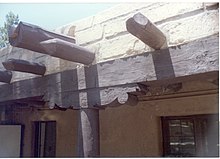



Vigas are wooden beams used in the traditional adobe architecture of the American Southwest, especially in New Mexico. In this type of construction, the vigas are the main structural members carrying the weight of the roof to the load-bearing exterior walls. The exposed beam-ends projecting from the outside of the wall are a defining characteristic of Pueblo architecture and of Spanish Colonial architecture in New Mexico, often replicated in modern Pueblo Revival architecture. Usually the vigas are simply peeled logs with a minimum of woodworking. In traditional buildings, the vigas support latillas[1] (laths) which are placed crosswise and upon which the adobe roof is laid, often with intermediate layers of brush or soil.[2] The latillas may be hewn boards, or - in more rustic buildings - simply peeled branches.[3] These building techniques date back to the Ancestral Puebloan peoples of 750 to 1300 CE, and vigas (or holes left where the vigas have deteriorated) are visible in many of their surviving buildings.
Since the popularization of the modern Pueblo Revival style in the 1920s and 1930s, vigas are typically used for ornamental rather than structural purposes. Noted Santa Fe architect John Gaw Meem (1894-1983) incorporated ornamental vigas into many of his designs. Contemporary construction in Santa Fe, New Mexico, which is controlled by stringent building-codes, typically incorporates ornamental vigas, although the 2012 revision of the residential building-code gives credit for structural vigas.[4] Older structures that have been reconstructed (e.g. the Palace of the Governors in Santa Fe) may contain both structural and ornamental vigas.
- ^ Latilla definition and meaning
- ^ Mountain Zamora, Luis (2015). "Taos Pueblo Preservation Program". APT Bulletin. 46 (4): 40. JSTOR 43659962.
- ^ Groben, W. Ellis (1941). Adobe Architecture: Its Design and Construction (PDF). U.S. Forest Service. Retrieved March 29, 2018.
- ^ City of Santa Fe (2012-01-11). "Draft Revisions to the Santa Fe Residential Green Building Code". Retrieved 2012-07-02.
